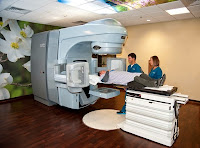The goal of Radiation Therapy for Prostate Cancer cells is to damage and stop their growth or kill them. This works because the rapidly dividing (reproducing) cancer cells are more vulnerable to destruction by the radiation therapy than are the neighboring normal cells.
Clinical trials have been conducted using radiation therapy for patients with organ-confined (localized) prostate cancer. These trials have shown that radiation therapy resulted in a rate of survival (being alive) at 10 years after treatment that is comparable to that for radical prostatectomy. Incontinence and impotence can occur as complications of radiation therapy, as with surgery, although perhaps less often than with surgery. More data are needed, however, on the risks and benefits of radiation therapy beyond 10 years, especially because late recurrences (reappearances) of the cancer can sometimes occur after radiation.
Choosing between radiation therapy and surgery to treat organ-confined prostate cancer involves considerations of the patient's preference, age, and coexisting medical conditions (fitness for surgery), as well as of the extent of the cancer. Approximately 30% of patients with organ-confined prostate cancer are treated with radiation therapy. Sometimes, oncologists combine radiation therapy with surgery or hormonal therapy in an effort to improve the long-term results of treatment in the early or later stages of prostate cancer.
- External beam radiation over perhaps six or seven weeks
- In external beam radiation, high energy X-rays are aimed at the tumor and the area immediately surrounding it.
- Or as an implant of radioactive seeds (brachytherapy) directly into the prostate.
- In brachytherapy, radioactive seeds are inserted through needles into the prostate gland under the guidance of transrectally taken ultrasound pictures. Brachy, from the Greek language, means short. The term brachytherapy thus refers to placing the treatment (radiation therapy) directly into or a short distance away from the cancerous target tissue. The theoretical advantage of brachytherapy over external beam radiation is that delivering the radiation energy directly into the prostate tissue should minimize damage to the surrounding tissues and organs.
Potential disadvantages of Radiation Therapy For Prostate Cancer include:
- A transient swelling of the prostate that may cause obstruction to the flow of urine and increase symptoms that may already be present because of an enlarged prostate.
Side effects of external beam Radiation Therapy For Prostate Cancer include:
- Skin burning
- or irritation
- and hair loss at the area where the radiation beam goes through the skin.
- Both can cause severe fatigue,
- diarrhea,
- and discomfort on urination.
These effects are almost always temporary. However, there are concerns about the long-term effects of radiation therapy, and although still not proven, some studies have reported a higher chance of developing bladder or rectal cancer many years after undergoing radiation therapy for prostate cancer. Although surgery can be done in case radiation therapy fails to cure prostate cancer (salvage radical prostatectomy), it is fraught with greater surgical difficulty and involves a significantly higher chances of complications like impotence and urinary incontinence.
